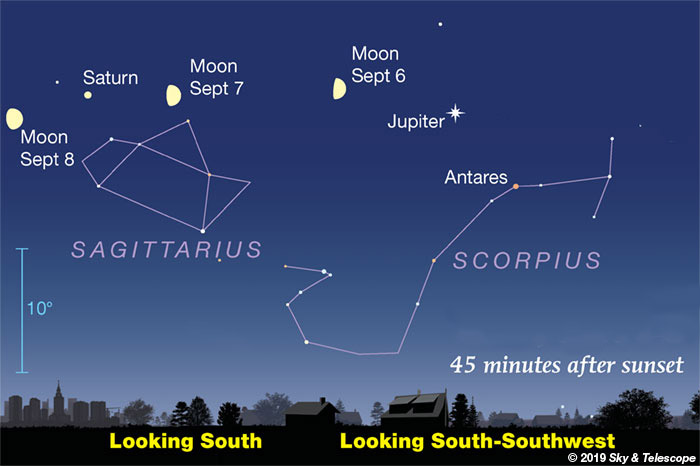
Friday, Sept. 6
• Tonight Neptune, magnitude 7.8, is a mere 1 arcminute southwest of Phi Aquarii, a 4th-magnitude orange star. You'll need a telescope to pick out Neptune. The pair is well up in the southeast by about 10 p.m. and highest in the south soon after midnight. For the rest of the week, Neptune and the star move farther apart by a little less than 2 arcminutes a day.
• The two brightest stars (not planets) of September evenings are Vega high overhead and Arcturus in the west, both magnitude 0.
Draw a line from Vega down to Arcturus. A third of the way down you cross the dim Keystone of Hercules. Two thirds of the way down you cross the dim semicircle of Corona Borealis with its one modestly bright star: Alphecca, the gem of the crown.
Well to the right of Arcturus, in the northwest, the Big Dipper is turning more and more level.
Saturday, Sept. 7
• Look left of the gibbous Moon at dusk for Saturn, as shown above. Much farther to the Moon's right is brighter Jupiter. Once night is fully dark, can you piece out the Sagittarius Teapot below the Moon and behind its light?
Sunday, Sept. 8
• Now Saturn glows to the Moon's right at dusk, as shown above.
• A winter preview: Step out before the first light of dawn this week, and the sky displays the same starry panorama it does at dinnertime around New Year's. Orion is striding up in the southeast, with Aldebaran and then the Pleiades high above it. Sirius sparkles far down below Orion. The Gemini twins are lying on their sides well up in the east. See Bob King's Good Morning, Orion!
Monday, Sept. 9
• As the stars come out tonight, the gibbous Moon shines in the south-southeast. Look high over it (by about 30°, three fists at arm's length) for Altair with faint Tarazed a finger-width above it. Near the zenith is brighter Vega.
• Neptune is at opposition tonight. It's now 5 arcminutes (almost 0.1°) to Phi Aquarii's west-southwest.
Tuesday, Sept. 10
• This evening the bright gibbous Moon shines inside the dim boat pattern of Capricornus. The brightest star high to the Moon's upper right is Altair, with little Tarazed a finger-width at arm's length beyond.
Watch lower left of the Moon, by some 20° or 30°, for twinkly, 1st-magnitude Fomalhaut to rise into view.
Wednesday, Sept. 11
• You know that the season is changing; we've reached the time of year when, just after nightfall, Cassiopeia has already climbed a little higher in the northeast than the Big Dipper has sunk in the northwest. Cas rules in early evening during the fall-winter half of the year. The Big Dipper takes over for the milder evenings of spring and summer.
Midway between them stands Polaris, currently a little above the midpoint.
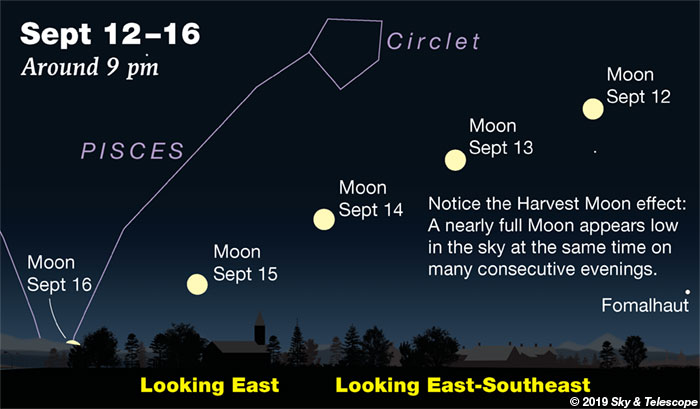
Thursday, Sept. 12
• Arcturus, the "Spring Star," shines a little lower in the west after dark each week. From Arcturus, the narrow kite-shaped pattern of Bootes extends 24° to the upper right.
Friday, Sept. 13
• Full Harvest Moon (exact at 11:33 p.m. Eastern Daylight Time). The Moon rises in the east shortly after sunset for North America, a lovely sight as twilight descends. After dark, look upper left of the Moon for the Great Square of Pegasus balancing on one corner (outside the frame above). The Square is made of 2nd- and 3rd-magnitude stars.
And then watch for 1st-magnitude Fomalhaut rising to the Moon's lower right, by about two fists at arm's length. How early can you see it? The farther south you live, the higher and easier Fomalhaut will be. The sky scenes here are always drawn for latitude 40° north.
Saturday, Sept. 14
• By the end of twilight the bright Moon, a day past full, has risen to shine low in the east. Look a couple of fists to its upper left for the Great Square of Pegasus, tipped onto one corner. The Square's lower left side points diagonally down at the Moon.
________________________
Want to become a better astronomer? Learn your way around the constellations. They're the key to locating everything fainter and deeper to hunt with binoculars or a telescope.
This is an outdoor nature hobby. For an easy-to-use constellation guide covering the whole evening sky, use the big monthly map in the center of each issue of Sky & Telescope, the essential guide to astronomy.

Once you get a telescope, to put it to good use you'll need a detailed, large-scale sky atlas (set of charts). The basic standard is the Pocket Sky Atlas (in either the original or Jumbo Edition), which shows stars to magnitude 7.6.
Next up is the larger and deeper Sky Atlas 2000.0, plotting stars to magnitude 8.5; nearly three times as many. The next up, once you know your way around, are the even larger Interstellarum atlas (stars to magnitude 9.5) and Uranometria 2000.0 (stars to magnitude 9.75). And read how to use sky charts with a telescope.
You'll also want a good deep-sky guidebook, such as Sue French's Deep-Sky Wonders collection (which includes its own charts), Sky Atlas 2000.0 Companion by Strong and Sinnott, or the bigger Night Sky Observer's Guide by Kepple and Sanner.
Can a computerized telescope replace charts? Not for beginners, I don't think, and not on mounts and tripods that are less than top-quality mechanically (meaning heavy and expensive). And as Terence Dickinson and Alan Dyer say in their Backyard Astronomer's Guide, "A full appreciation of the universe cannot come without developing the skills to find things in the sky and understanding how the sky works. This knowledge comes only by spending time under the stars with star maps in hand."
This Week's Planet Roundup
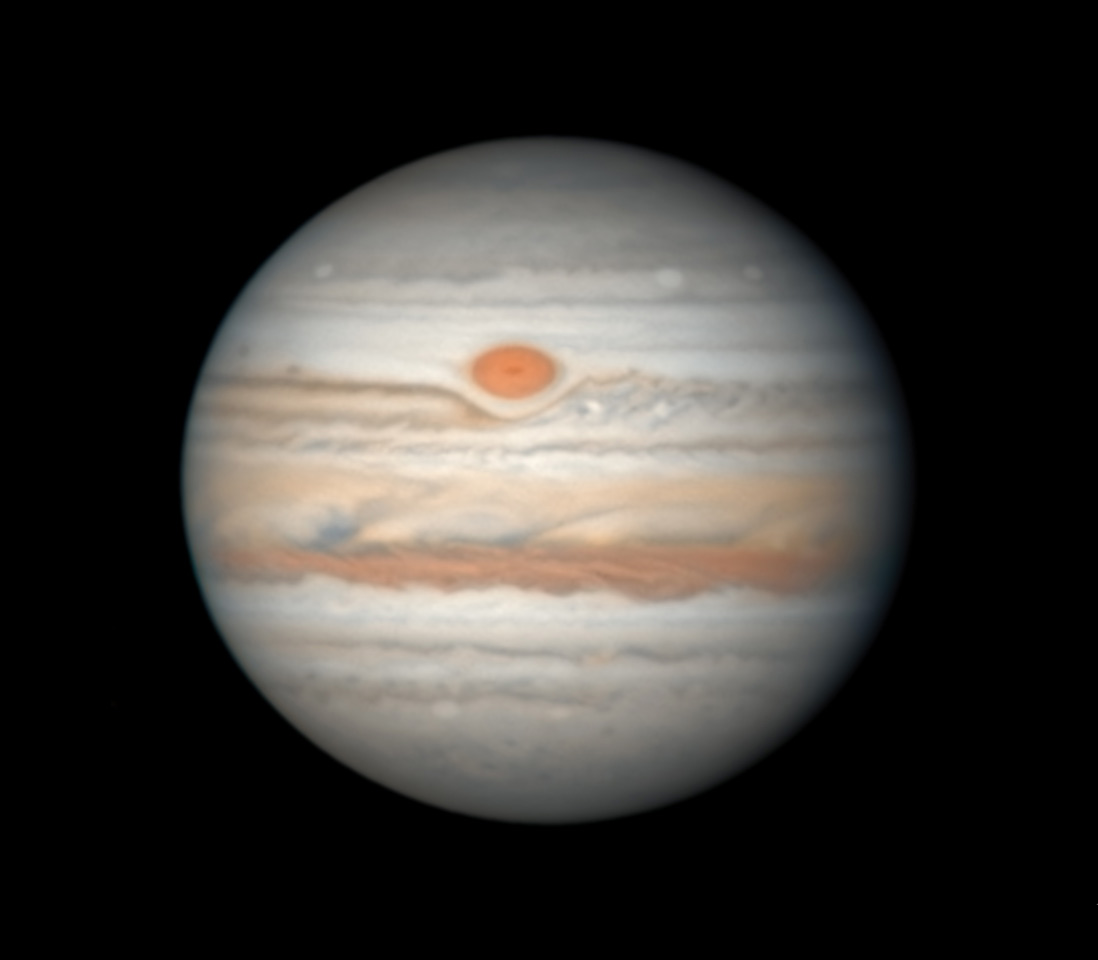
Jupiter (magnitude –2.2, between the feet of Ophiuchus) is the white dot hanging in the south-southwest as twilight fades away. Get your scope on it early before it sinks lower into even poorer seeing. Orange Antares, much fainter at magnitude +1.0, twinkles 7½° to Jupiter's lower right. In a telescope, Jupiter is only 38 arcseconds wide and shrinking.
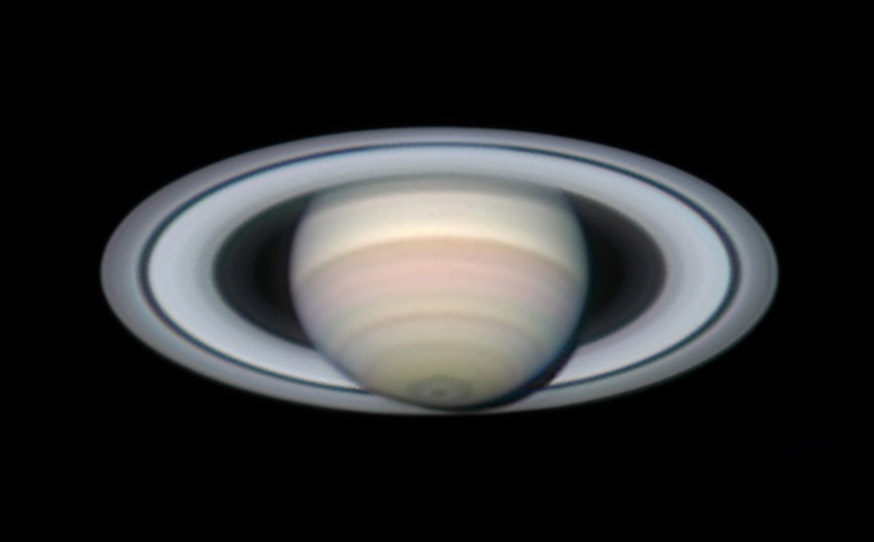
Saturn on August 23rd, imaged by Damian Peach with the 1-meter Chilescope. South is up. "Poor to fair seeing allowed a reasonable result," he writes. That's being modest. With a scope that large at a latitude where Saturn is high overhead, the North Polar Hexagon and its central dark spot show here clear as day.
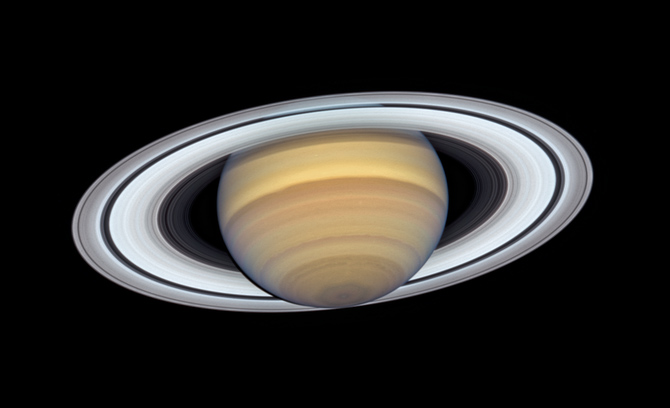
Saturn (magnitude +0.4, in Sagittarius) is the steady, pale yellowish "star" in the south-southeast during and after dusk, 28° left or upper left of Jupiter. Below Saturn is the handle of the Sagittarius Teapot.
Uranus (magnitude 5.7, in Aries) is well up in the east by 11 or midnight daylight saving time and highest in the south around 3 or 4 a.m.
Neptune (magnitude 7.8) is at opposition this week (the night of September 9th) and is passing 4th-magnitude Phi Aquarii. The star and planet are only about 1 arcminute apart on the 6th — you'll need a telescope — and after that they steadily widen to 12 arcminutes (0.2°) apart on the 13th. They're well up in the southeast by about 10 p.m. and are highest in the south soon after midnight. Finder charts for Uranus and Neptune.
_________________
All descriptions that relate to your horizon — including the words up, down, right, and left — are written for the world's mid-northern latitudes. Descriptions that also depend on longitude (mainly Moon positions) are for North America.
Eastern Daylight Time (EDT) is Universal Time (UT, UTC, GMT, or Z time) minus 4 hours.
_________________
Audio sky tour. Out under the evening sky with your earbuds in place, listen to Kelly Beatty's monthly podcast tour of the heavens above. It's free.
_________________
"The dangers of not thinking clearly are much greater now than ever before. It's not that there's something new in our way of thinking, it's that credulous and confused thinking can be much more lethal in ways it was never before."
— Carl Sagan, 1996
 6
6








Comments
Anthony Barreiro
September 6, 2019 at 4:12 pm
I've been following Neptune through 10x42 image-stabilized binoculars. The eighth-magintude planet has been fairly easy to find moving slowly westward just east of Phi Aquarii. Two sixth-magnitude stars a couple of degrees east of Phi create a narrow isoceles triangle that has neatly framed Neptune; now Neptune is leaving the point of the triangle, heading west from Phi. The past few nights have been cloudy here in San Francisco, so I don't know if Neptune can be resolved so close to fourth-magnitude Phi.
Repeating my previous comment: S&T's finder chart for Neptune and Uranus is not very helpful. The closest naked eye asterism to Neptune is the water jar of Aquarius; the closest asterism to Uranus is the horn of Aries. Separate finder charts for the two planets that include each of these star patterns would be much more useful than the current chart with Neptune and Uranus squeezed into the corners around Pisces.
You must be logged in to post a comment.
Rod
September 6, 2019 at 8:37 pm
Anthony, I will try to view Neptune near Phi Aquarii tonight, perhaps 2200-2300 EDT. The skies are clearing now. Dorian is moving away in the Atlantic, earlier today some rain and winds but not too bad for my location in Maryland, coastal areas had more. I will use my 90-mm refractor with Telrad. Finder charts - I use Stellarium 0.19.1 and Starry Night Pro Plus 8. Phi and Neptune are close to one arcminute angular separation tonight as Neptune retrogrades in Aquarius. Neptune began retrograde motion on 21-Jun-19 in Aquarius, some 1.3 degrees or so east of Phi. It is fun to track this celestial dance of the planets near the ecliptic 🙂 At 179x to 200x, I should be able to see Neptune bluish disk.
You must be logged in to post a comment.
Rod
September 7, 2019 at 12:24 am
Anthony, it worked. I could see Phi Aquarii and Neptune in same field of view using 71x and 111x views. My barlow lens fogged up so nothing higher. The fainter, bluish Neptune and Phi Aquarii, red giant somewhat reminded me of Albireo double star colors but these two are brighter.
You must be logged in to post a comment.
Anthony Barreiro
September 8, 2019 at 3:34 pm
Hi Rod. I'm happy to hear you were able to see Neptune. Last night my astronomy club had our monthly public night on Mount Tamalpais. I took mounted 15x70 binoculars and showed visitors the Moon. By 10:30 pm Neptune was well up in the southeast. The color contrast between Neptune and Phi Aqr was beautiful.
You must be logged in to post a comment.
Tom-Reiland
September 8, 2019 at 6:07 pm
I believe your time for the Full Moon is off by an hour. If it's 4:33 UT on Saturday, then it should be 12:33 EDLT (Eastern Daylight Later Time) on Saturday.
You must be logged in to post a comment.
misha17
September 11, 2019 at 7:50 pm
I hate to "crash" this entry, but the Harvest Full Moon this year falls on a Friday the 13th, there may be reports that this only happens every 20 years. I found an blog entry on a radio station's website that quoted the Farmer's Almanac for that fact - https://fm106.iheart.com/content/2019-09-09-how-to-see-the-rare-harvest-moon-on-friday-the-13th/?Pname=local_social&Sc=editorial&Keyid=socialflow&fbclid=IwAR1eQh7rV4ro-rLNlZh9XtuyGIVKzcvqb1ZJ53c6u-wt89cF36Cc7kNGHNI - and it says the last "Harvest Moon" was Oct 13 2000, and the next will be on August 13 (!?) 2049.
Both Full Moons on those dates were not "Harvest Moons".
Just like we now have articles about "Blood Moons", "Black Moons", and "Mars will appear as large as the Full Moon", expect a few more articles about "1st Harvest Moon 20 Years!" this week.
You must be logged in to post a comment.
You must be logged in to post a comment.